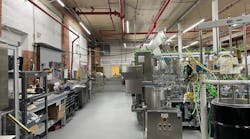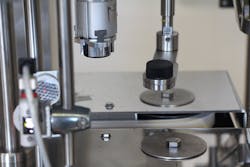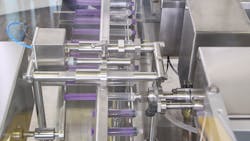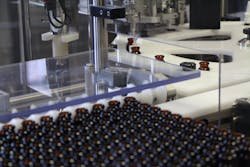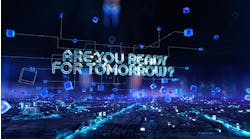TurboFil Packaging Machines capitalizes on demand for prefilled syringes
TurboFil Packaging Machines, founded in 1999, designs and manufactures liquid filling and assembly machines for the pharmaceutical industry primarily, but also cosmetics, chemical and defense industries. The company employs 24, including 10 engineers, and its customers are primarily research labs, contract packagers, mainstream drug manufactures and pharmacies. “The common denominator is that each of these niches often needs customized equipment involving the handling or filling of liquid medicines or diagnostic fluids,” says Deborah Smook, managing director of TurboFil Packaging Machines.
The growing market for prefilled syringes and drug device combination products have been dominant drivers of the machine builder’s recent business. Single-use formats are particularly popular, Smook says, because of convenience and efficiency. Prefilled syringes eliminate the time and effort drawing from a vial. “Another corresponding factor is accuracy because prefilled syringes come with the exact dosage. Prefilled syringes are also safer, since having to draw from a container presents an additional opportunity for a needlestick injury,” Smook says.
On the manufacturing side, prefilled syringes eliminate the need to slightly overfill a draw container to allow for overfills or wastage during drawing. “Drugs of certain thicker viscosities are exceedingly difficult to draw manually, so typically require overfilling,” she adds.
“We’re also seeing an increasing need for automation in production, especially for inspection processes,” she adds. The ongoing labor shortage is affecting all of its target markets, pushing them toward automation. Traditionally, prefilled syringe inspection was done manually, but, Smook says, the sheer volume produced by automated machines make inspection impractical and probably impossible.
“Automated inspection is also more accurate—in many cases exponentially so. The sophistication of automated inspection systems provides precise quality control through high-resolution, high-speed-capable cameras, reportable findings and, increasingly, machine learning that improves as production perpetuates. There is simply no way humans can replicate those levels of precision and reliability,” Smook says.
“Also, companies are struggling to hire experienced mechanics and engineers to maintain equipment; this means our focus must be on equipment that can be easily changed over by operators, and requires as little maintenance as possible,” Smook says. “Automation has become a labor necessity, rather than a cost-cutting convenience.”
The labor shortage is also escalating the need for remote assistance capabilities. TurboFil uses Ewon Cosy for remote connectivity to machines on-site extensively to support customer operations. The machine builder provides broad diagnostic tests remotely, as part of its maintenance after-market services, as well as remote instruction to correct issues and optimize production.
“We try to limit the required maintenance to cleaning and wear part replacement. If there is a machine malfunction, we often remotely diagnose and direct the customer’s mechanic in the resolution,” Smook says. TurboFil recommends that customers order spare sets of product contact components that require thorough cleaning; then the machine can run with spares while the first set of components are being cleaned.
“We design our machines for easy changeover and removal/reinstallation of components for cleaning. Toolless design is used whenever possible. Clear marking, color coding and other techniques are used to reduce user error and the need for manual reference,” Smook adds.
Data logging and machine inspection
The machine builder is focused on improving machine efficiency with data. “Multiple timers are used to record each movement step, building a database of motion timing for each station. We use this to optimize every step, identifying suboptimal movement to improve overall performance,” Smook says. Generally, production optimization tools focus on the most volatile aspects of a production line, she says, and like any metrics-driven tools, the optimization systems become better over time.
TurboFil Packaging Machines is active in the unit dose nasal spray (UDS) space, producing machines to fill and assemble the devices. A new UDS application was approved for over-the-counter use, as Naloxone, the opioid reversal drug. TurboFil’s machine design for producing this life-saving drug incorporates multiple high-level inspection stations that use data logging. The inspections are a required and important process. “This project demands the highest possible quality control. Naloxone is designed to save the life of someone who may be minutes away from dying from opioid overdose; there simply isn’t any room for error in that situation, meaning the drug and its device must perform pristinely,” says Smook. Automated inspection is the only means for quality control on such high volumes.
The system is controlled by a Rockwell Automation ControlLogix programmable logic controller (PLC) and Maple Systems human-machine interface (HMI). There are four vision inspection systems and a variety of sensors, three servo-operated assembly actuators and data logging capabilities.
Sixty percent of TurboFil’s machines are either largely or fully customized. The company offers a range of highly customized platform machines, specializing in equipment solutions for difficult-to-handle products and specialized components, including injection devices, unique inhaler construction and various cartridges and containers, and working with highly viscous material, syringes and nasal delivery systems. The machine line includes 10 automatic systems and 40 manual or semi-automatic benchtop modules. The company works primarily in the United States and Canada but has also provided machines to overseas countries, including Qatar, Israel, the Philippines, Chile and France.
TurboFil’s highly customized machines take from six months to a year to go from full design to development and production. “At the inception of each project, we assess the technical obstacles of the design and accelerate those that are expected to be the most challenging. We often prototype specific stations to test our design concepts, which helps us remain versatile and prepared for rapid design changes should issues arise during the machine build,” Smook says.
All designs are completed in the Solidworks 3D CAD environment. “This allows us to collaborate from diverse locations and share design concepts with customers,” Smook says.
Some of TurboFil’s most innovative machines include the following.
- TurboFil’s Acrobat Chuck Capper is a servo-driven unit with precision torque and gentle handling, ideal for manufacturers producing multiple SKUs. It is available in single- and dual-head formats capable of processing up to 90 units per minute (Figure 1). Its proprietary technology and parallel belts eliminate the expense of making and storing change parts for most bottles. For the smallest bottles, minor, inexpensive parts are needed for easy changeover. “The module’s two-chuck system features a novel ‘chasing chuck’ that automatically locates the next bottle along the belt. This mobile, adjustable chasing chuck allows the belt itself to serve as a spacing tool, eliminating the need for costly, time-consuming change parts,” Smook says.
- Suitable for small to medium batches, TurboFil’s SimpliFil Syringe Filling & Assembly System has precise setup that accurately fills syringes with versatility via ceramic piston, peristaltic pump or direct draw from a reservoir bag (Figure 2). A walking beam indexing configuration is used for intuitive operation and simplified, recipe-based changeover. “For heightened precision, TurboFil's unique TipFil technology allows syringes to be filled through the tip—a step-saving innovation eliminating the need to insert plungers post-filling. Filling up to 20 syringes per minute, the SimpliFil system smoothly handles syringes with tips outfitted for press-on caps and luer caps, as well as various safety caps recently incorporated for oral syringes,” Smook says.
- TurboFil’s benchtop TipFil Syringe Draw Filler has full control of filling parameters in single or dual operation. The unit’s piston mechanism draws back the plunger, with the distance the plunger is pulled back dictating the amount of drug filled. “Among other benefits, this eliminates the need to clean a metering device,” Smook says. The plunger motion is driven by a servo motor for precise, repeatable product filling, at up to 12 pieces per minute.
- TurboFil’s Mini-Monoblock MDN-50 is an automatic machine for the inline filling and capping of multi-dose nasal dispensers. The module fills, seals, caps and labels nasal spray containers at a rate of up to 50 pieces per minute (Figure 3). “The new system is optimized from the inception of the filling process to its conclusion. For starters, a scroll conveyor allows for seamless vial loading while allowing for an exceedingly compact overall footprint. Vials are then transported to a starwheel ceramic piston filler station for clean and accurate filling,” she adds. The filler station can incorporate a second nozzle for customers requiring even faster filling with the same exacting process.
